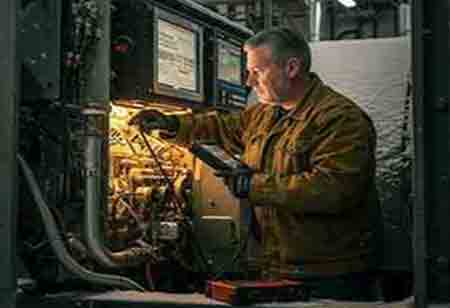Thank you for Subscribing to Electrical Business Review Weekly Brief
I agree We use cookies on this website to enhance your user experience. By clicking any link on this page you are giving your consent for us to set cookies. More info
Generator Services: Ensuring Reliability in Canada's Power Supply
Canada’s electric generator repair service industry is undergoing a significant and often underestimated transformation.

By
Electrical Business Review | Friday, October 17, 2025
Stay ahead of the industry with exclusive feature stories on the top companies, expert insights and the latest news delivered straight to your inbox. Subscribe today.
Canada's electric generator repair service industry is transforming significantly, becoming a critical component of operational resilience across sectors: digital innovation, environmental policy shifts, and increasing demand for uninterrupted power drive this transformation. The industry is reshaping service models, workforce skills, and the role of repair providers nationwide, making generator repair services essential for hospitals, data centers, and remote industrial sites.
Emerging Trends Redefining the Generator Market
Canada’s generator repair landscape is no longer confined to basic mechanical fixes. The trend curve is sharply rising toward intelligent diagnostics, predictive maintenance, and smart integration. Generators are paired with sensors and IoT-powered control units that detect real-time anomalies and communicate directly with service providers. This shift is ushering in a service culture prioritizing prevention over reaction, pushing the sector into more sophisticated, tech-driven territory.
Another clear pattern is the diversification of energy sources. While diesel and natural gas generators still dominate, clients increasingly invest in hybrid systems combining solar arrays, battery storage, and traditional generators. These setups require new diagnostic frameworks and deeper technical fluency from repair personnel. Field technicians are no longer just mechanically inclined; they are evolving into multi-disciplinary problem-solvers fluent in renewable technologies and digital platforms.
The rise in infrastructure investments across provinces is also catalyzing demand. From remote indigenous communities electrifying through microgrids to telecom towers requiring uninterrupted power in northern regions, the need for scalable and responsive generator repair support is expanding in scope and complexity.
Industry Challenges Fueling Innovation
This evolution hasn’t been without strain. A significant constraint lies in talent availability. Many seasoned professionals are nearing retirement, and younger entrants often lack the niche skills needed for today’s generator systems. Compounding the issue is a fragmented training ecosystem; few standardized certifications exist for hybrid system repair, and regional disparities in codes and practices make cross-province consistency difficult.
Supply chain disruptions have added further complications. Long lead times on parts, fluctuating prices for components, and logistical headaches in remote areas stretch repair timelines. These delays can have serious operational and financial consequences, especially in critical facilities where even brief outages cost millions.
However, the sector responds with ingenuity rather than buckle under these pressures. Companies are deploying mobile diagnostic units and custom-outfitted vans that operate as workshops on wheels, reducing turnaround times and providing on-site precision servicing. Others are using AI-assisted triaging systems that assess real-time service requests and match them with technician availability, skill set, and proximity, streamlining dispatch and execution.
Another innovation quietly gaining traction is subscription-based service models. By moving away from on-demand repairs and toward all-inclusive service contracts, providers can forecast revenue more accurately while clients benefit from guaranteed priority access, remote monitoring, and performance audits. It’s a business model that aligns better with uptime-focused industries like healthcare, logistics, and finance.
Unlocking Opportunities Through Smart Adaptation
The opportunities unfolding across Canada’s generator repair sector are as diverse as the country’s energy needs. For one, climate resilience planning is pushing organizations to rethink their energy continuity strategies. Ice storms, wildfires, and floods are more frequent, and backup power isn’t a luxury—it’s a mandate. This urgency opens the door for service providers who can deliver climate-adaptive, high-efficiency maintenance with minimal downtime.
As environmental regulations tighten, there’s also a lucrative retrofitting and emissions compliance space opening. Many legacy generators still in operation are not aligned with Canada’s emissions goals. Companies offering emissions retrofitting, biofuel compatibility upgrades, and low-noise system optimizations are tapping into a niche but growing demand. This is especially relevant in urban zones where municipalities tighten generator emissions and noise pollution restrictions.
On the technological frontier, digital twin technology is reshaping how systems are understood and serviced. By creating virtual replicas of real-world generator systems, technicians can simulate wear-and-tear scenarios, test interventions, and predict part failures before they manifest in the physical equipment. Combined with augmented reality repair tools, which guide technicians step-by-step using smart glasses, this development redefines what efficient field service can look like. For forward-thinking stakeholders, these advancements represent operational improvements and strategic value. Energy resilience is now part of boardroom discussions, and partnerships with generator repair experts are increasingly viewed as risk mitigation assets rather than mere vendors.
Canada’s generator repair service industry appears poised for a new era marked by specialization, digitization, and environmental alignment. The companies that will thrive are those that embed innovation into their operations, not as an afterthought, but as a foundation. By investing in technician training, embracing automation, and tailoring services to emerging energy realities, stakeholders can unlock long-term value while playing a critical role in Canada’s broader energy transformation. In this new landscape, adaptability isn’t optional; it’s the engine of growth.








